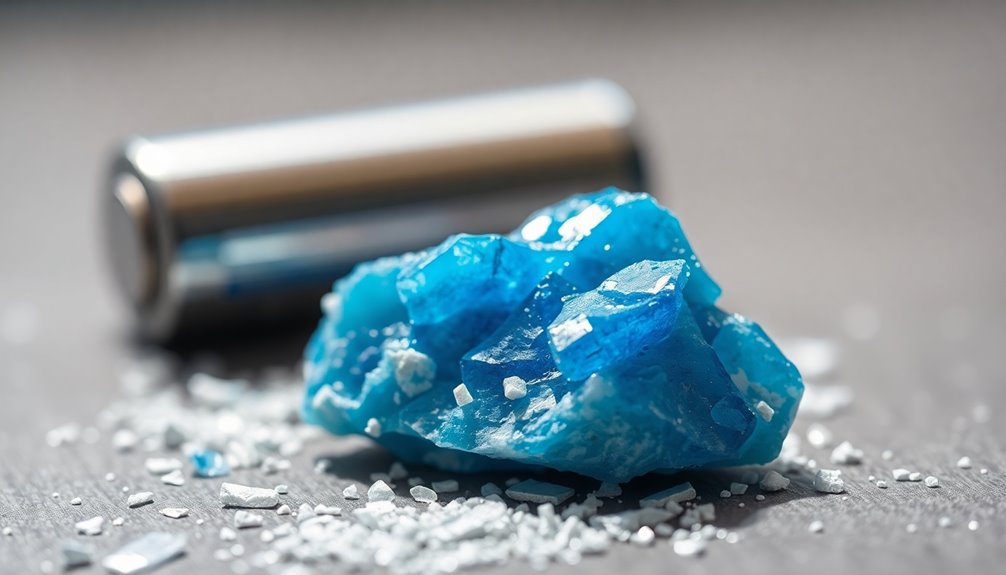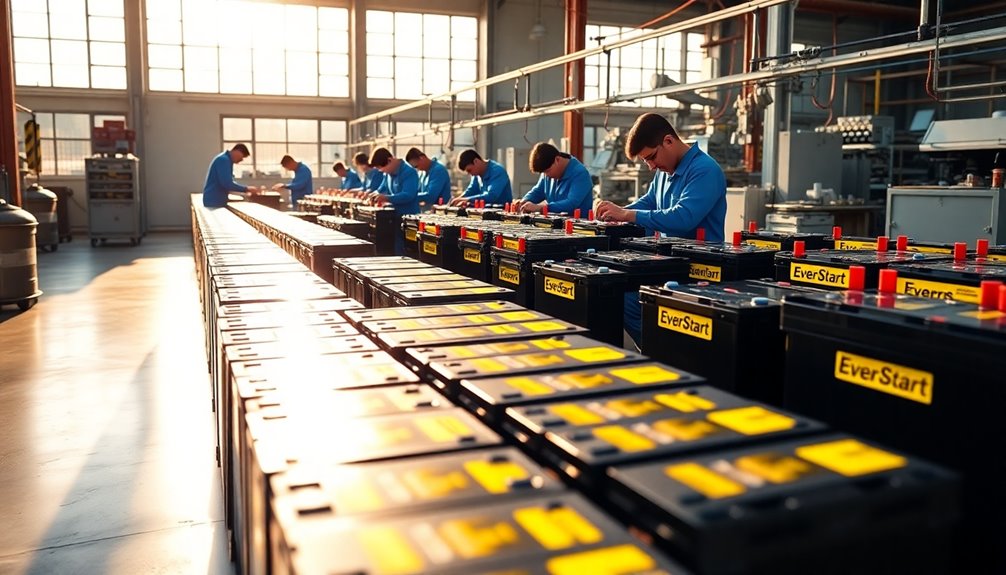You might be surprised to learn that lithium, cobalt, and graphite are the essential mineral resources used to make batteries today. Lithium is lightweight and has an excellent energy storage capacity, making it vital for high-performance batteries. Graphite serves as the primary anode material, while cobalt enhances energy density and stability, particularly in lithium-ion batteries. The growing demand for these minerals is driving technological innovation and raising sustainability concerns related to their extraction. Want to know more about how these resources impact technology and the environment? There's so much more to explore!
Key Takeaways
- Lithium is a lightweight mineral with high energy storage capacity, essential for lithium-ion batteries used in electronics and electric vehicles.
- Graphite serves as the primary anode material in lithium-ion batteries, facilitating energy storage and improving performance.
- Cobalt enhances the energy density and stability of lithium-ion batteries, making it crucial for portable electronics.
- The demand for battery minerals, including lithium, graphite, and cobalt, is projected to double by 2025, raising sustainability concerns.
- Ethical sourcing and recycling of these minerals are vital to mitigate environmental impact and improve community welfare.
Overview of Battery Minerals
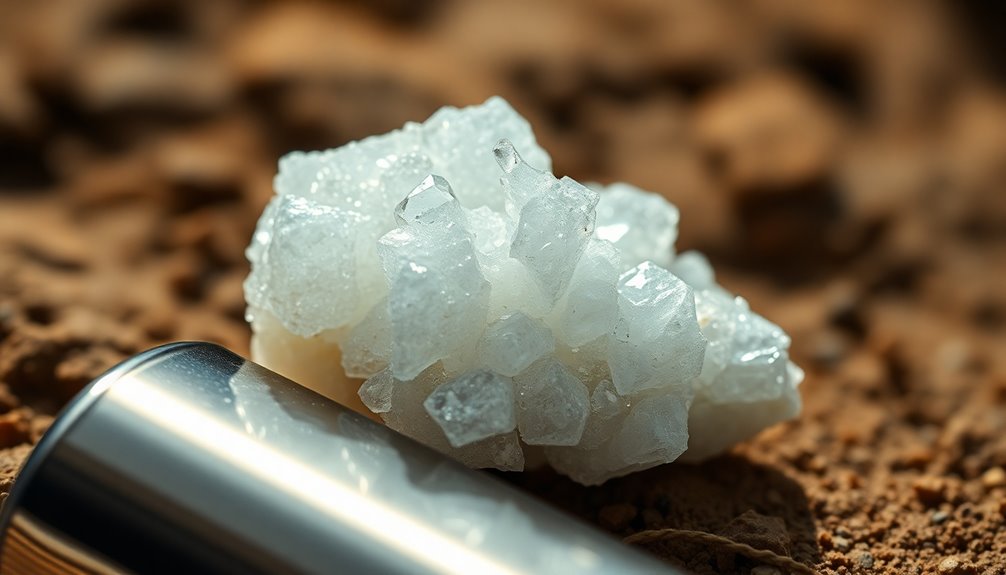
Battery minerals play an essential role in powering our modern electronic devices and electric vehicles. Among these, graphite is important as it serves as the anode material in lithium-ion batteries, enabling effective storage and release of electrical energy.
Alongside graphite, lithium is significant due to its lightweight nature and high energy storage capacity, enhancing battery performance. Cobalt also plays a significant role, especially in lithium cobalt oxide compounds, which offer a powerful yet lightweight solution for devices like smartphones and laptops.
With the demand for these battery minerals projected to double by 2025, sustainability and ethical sourcing become critical issues, particularly for cobalt mining in regions like the Democratic Republic of the Congo. Your awareness of these factors can lead to more responsible choices.
Role of Graphite in Batteries
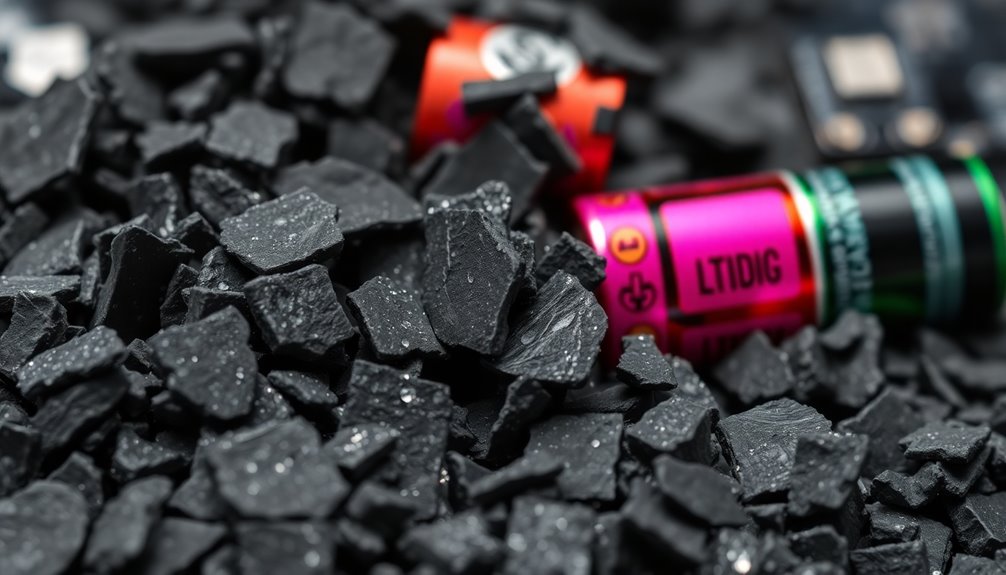
Graphite plays an essential role in batteries, mainly as the primary anode material.
Its excellent electrical conductivity allows for efficient energy storage and release, enhancing battery performance.
With global sources like China, Canada, and Brazil, you can see how important graphite is for meeting the rising demand for electric vehicles and renewable energy solutions.
Graphite's Electrical Conductivity
While many materials can be used in energy storage, graphite stands out as a key player due to its exceptional electrical conductivity. This property is vital for the performance of lithium-ion batteries.
Here's why graphite is indispensable:
- Efficient Energy Storage: Graphite allows for effective storage and release of electrical energy.
- Ion Movement: It facilitates the intercalation and deintercalation of lithium ions during charging and discharging.
- Enhanced Energy Density: Graphite's conductivity boosts the overall energy density, leading to longer battery life.
- Widespread Availability: With deposits in China, Canada, and Brazil, graphite supports the increasing demand for battery production.
- Health Benefits: Moreover, the use of graphite in batteries contributes to improved air quality, especially as electric vehicles reduce emissions from traditional fuel sources.
In short, graphite's electrical conductivity is essential for the functionality of modern devices like smartphones and electric vehicles.
Anode Material Importance
The role of anode materials in lithium-ion batteries is pivotal, and graphite's unique properties make it the top choice.
Graphite allows for efficient storage and release of lithium ions during charge and discharge cycles. When you charge your battery, lithium ions intercalate into the graphite structure, while during discharge, they deintercalate back to the cathode, enabling a smooth flow of electrical current.
This electrical conductivity of graphite greatly boosts the energy density and performance of batteries, making them ideal for electronic devices and electric vehicles.
As demand for electric vehicles rises, the market for graphite is expanding, underscoring its critical importance in the shift to renewable energy solutions.
Consequently, graphite remains essential for sustainable battery technology.
Global Graphite Sources
Natural and synthetic graphite sources are essential for meeting the rising demand for lithium-ion batteries. As you explore this critical resource, consider these key points:
- Primary Anode Material: Graphite is the main anode material, enabling efficient lithium ion storage and release.
- Major Producers: China, Canada, and Brazil dominate global natural graphite production, supplying a substantial portion of the market.
- Synthetic Graphite: Widely produced, synthetic graphite enhances battery performance and energy density.
- Growing Demand: The surge in electric vehicles and portable electronics drives a dramatic increase in graphite market growth.
With its excellent electrical conductivity and endurance through multiple charge cycles, graphite plays an indispensable role in the efficiency and longevity of lithium-ion batteries.
Importance of Lithium

As the world becomes increasingly reliant on technology, lithium emerges as an essential resource for powering our devices and vehicles.
Lithium-ion batteries are at the heart of this transformation, providing the high energy density and lightweight properties needed for smartphones, laptops, and electric vehicles.
With demand projected to double by 2025, the need for lithium is more urgent than ever.
While extraction mainly occurs in regions like Chile and China, innovative methods, such as extracting lithium from wastewater produced by Marcellus shale gas wells in Pennsylvania, show promise.
Researchers have achieved over 90% efficiency in this process, offering a sustainable solution.
The U.S. government's push for enhanced domestic lithium production by 2030 could further boost energy independence and reduce reliance on foreign sources.
Cobalt's Contribution to Battery Technology
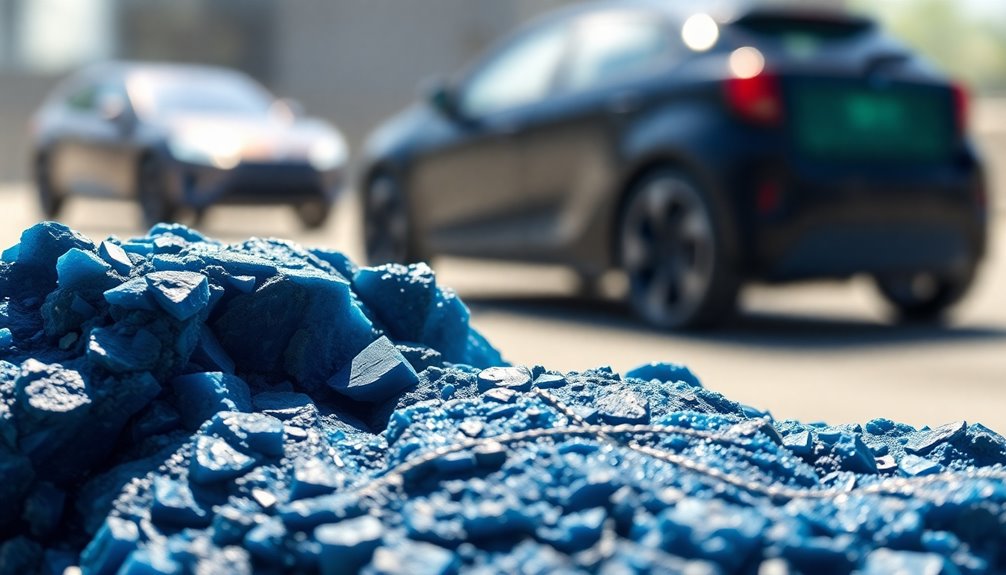
Cobalt plays a crucial role in enhancing the performance of lithium-ion batteries, making them more efficient and longer-lasting.
However, its extraction raises significant health and ethical concerns, especially regarding working conditions in mines.
As you explore cobalt's contributions to battery technology, it's important to reflect on both its benefits and the challenges that come with sourcing it responsibly.
Cobalt's Role in Batteries
While many components contribute to the effectiveness of lithium-ion batteries, cobalt stands out as a vital ingredient that enhances energy density and stability.
Here's why cobalt is so important in battery technology:
- Energy Density: Cobalt compounds, specifically lithium-cobalt oxide (LiCoO2), considerably improve the energy density of batteries.
- Stability: Cobalt enhances the thermal stability of batteries, reducing the risk of overheating.
- Lightweight: Cobalt keeps batteries lightweight, making them ideal for portable electronics and electric vehicles.
- Growing Demand: With the demand for lithium-ion batteries expected to double by 2025, cobalt's role will become even more essential.
As we rely more on these technologies, understanding cobalt's role is key for both innovation and sustainability in battery production.
Health Risks of Cobalt
The impressive advantages of cobalt in battery technology come with significant health risks that can't be overlooked. You might not realize that cobalt mining exposes workers, including children, to hazardous conditions. These operations are linked to severe health issues, like respiratory diseases and toxic metal exposure, affecting local communities profoundly.
| Health Risk | Description | Impact on Communities |
|---|---|---|
| Respiratory Diseases | Caused by dust and chemical exposure | Increased hospital visits |
| Toxic Metal Exposure | Contaminated soil and water | Long-term health complications |
| Environmental Pollution | Poor regulation enforcement | Contaminated food supply |
| Child Labor | Miners are often underage | Educational opportunities lost |
As demand for cobalt skyrockets, these health risks of cobalt can't be ignored.
Environmental Impact of Mining

Mining operations for essential minerals like cobalt have a profound environmental impact, often leading to pollution that contaminates local soil, water, and food supplies. This situation is especially dire for vulnerable populations, including children.
Here are some key concerns:
- Elevated levels of toxic metals found in urine of communities near mining sites.
- Poor enforcement of environmental regulations worsens ecosystem degradation.
- Dust from mining operations causes respiratory diseases among nearby residents.
- Long-term biodiversity loss threatens local agriculture and ecosystems.
These issues highlight the urgent need for safer mining practices.
The environmental impact extends beyond immediate communities, affecting broader ecological systems and calling for a collaborative approach to guarantee sustainability in mining operations.
Future Trends in Battery Materials

As electric vehicles gain popularity, innovations in battery materials are rapidly evolving to meet growing demands.
You'll notice that the industry is shifting away from traditional resources like graphite and cobalt, pushing for alternative materials to enhance performance. Researchers are focusing on synthetic graphite technology to improve energy density in rechargeable batteries, while also exploring silicon and other compounds for anode materials.
This shift aims to boost energy storage capacity and sustainability. Additionally, regulatory frameworks and heightened consumer awareness are driving the need for ethical sourcing and environmentally responsible practices in mining and production.
As these trends continue, the future of battery materials promises more efficient and sustainable solutions for electric vehicles.
Recycling Battery Components
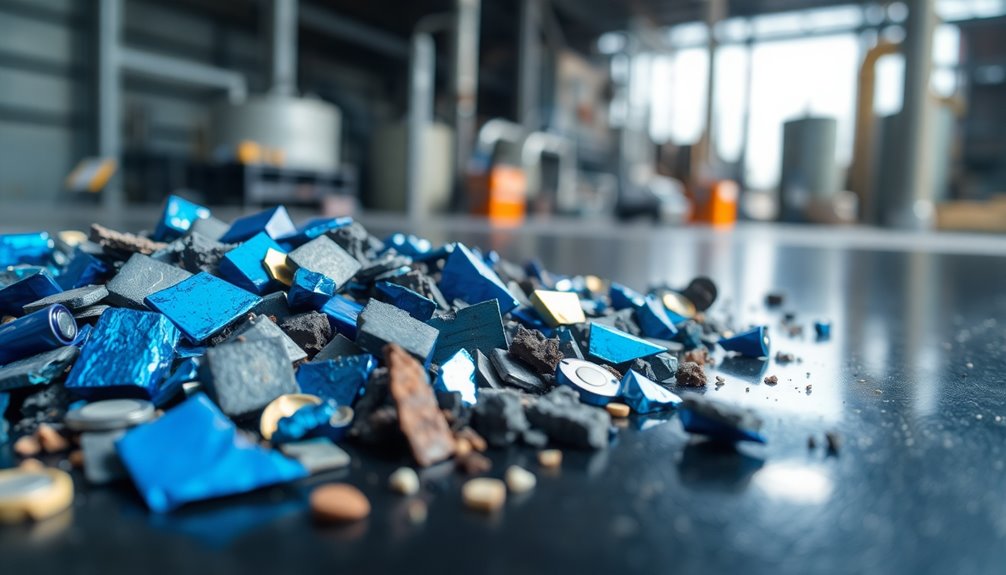
With the rapid advancements in battery materials, the importance of recycling battery components is becoming increasingly clear.
As demand for used batteries rises, effective recycling is essential for sustainability.
Here are four key benefits of recycling:
- Resource Conservation: About 95% of lithium-ion battery components can be reclaimed.
- Cobalt Recovery: Advanced technologies can recover up to 90% of cobalt from used batteries.
- Waste Reduction: Recycling minimizes waste and lowers the need for new mining operations.
- Market Growth: The global battery recycling market is expected to hit $23 billion by 2027, thanks to rising electric vehicle production.
Sustainable Sourcing Practices

While the demand for battery minerals like lithium and cobalt continues to surge, sustainable sourcing practices are becoming fundamental for meeting this need responsibly. Companies are now urged to adopt ethical sourcing standards to combat labor rights violations and environmental degradation, especially in places like the Democratic Republic of the Congo.
Recycling plays an essential role in sustainable sourcing practices, focusing on recovering materials from spent batteries. Regulatory frameworks are evolving to enhance environmental protection, while collaboration among governments, NGOs, and private sectors is critical for developing responsible supply chains.
| Focus Area | Key Action | Impact |
|---|---|---|
| Ethical Sourcing | Address labor rights | Improved community welfare |
| Environmental Protection | Reduce degradation | Healthier ecosystems |
| Recycling | Recover materials | Decreased mining demand |
| Collaboration | Partnership building | Stronger supply chains |
Frequently Asked Questions
Which Mineral Is Used to Make Batteries?
When you think about which mineral is used to make batteries, you'll find that graphite, lithium, and cobalt are key players.
Graphite acts as the anode material, while lithium enhances energy density, making your devices last longer.
Cobalt contributes to the battery's lightweight and powerful nature.
With the rise in electric vehicles and portable electronics, the demand for these minerals is skyrocketing, emphasizing the need for sustainable and ethical sourcing practices.
Which Material Resource Is Used to Make Batteries?
Picture a sleek electric vehicle gliding silently down the street, powered by advanced technology.
When you think about which material resource is used to make batteries, graphite stands out. It's the unsung hero, forming the anode that stores and releases energy.
You'll also find lithium and cobalt in the mix, boosting performance.
As the demand for batteries skyrockets, recycling these materials becomes essential for a sustainable future, ensuring we don't drain the Earth's resources.
Which Mineral Resource Is Used to Make Batteries Quizlet?
When you're diving into the world of battery materials, you'll find graphite and lithium are key players.
Graphite's your go-to for the anode, while lithium powers the charge. As electric vehicles and gadgets surge in popularity, the demand for these minerals skyrockets.
Countries like China, Canada, and Brazil are major sources of graphite.
Don't forget that sustainability and recycling are becoming critical as we endeavor to meet this growing demand responsibly.
Which Mineral Resource Is Used to Make Batteries of Graphite?
You might be surprised to learn that graphite is essential for making batteries, especially lithium-ion ones.
It acts as the primary anode material, allowing efficient storage and release of energy. When lithium ions move in and out of graphite layers, they enhance the battery's energy density and longevity.
With the rise in demand for electric vehicles and portable electronics, understanding graphite's role is vital for advancing battery technology and sustainable sourcing practices.
Conclusion
As you explore the world of battery minerals, think of a vibrant landscape where each element plays an essential role in powering our future. Graphite's sleek shimmer, lithium's energetic spark, and cobalt's steadfast strength come together like a symphony, driving innovation forward. Yet, as we embrace these resources, let's tread lightly, ensuring our journey is sustainable. By recycling and sourcing responsibly, you can help keep this landscape lush and thriving, fueling tomorrow's technologies without compromising our planet.

